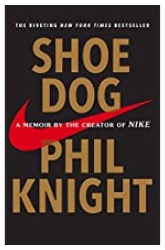Sometimes we look at a modern success story and we get a false impression about what actually happened in the past. We see only the victories; we forget about the obstacles that were overcome along the way.
I take a strange comfort in knowing that while Thomas Jefferson was writing the Declaration of Independence, he was worried about his wife who was sick at home. Lincoln was depressed during much of his life and his wife was a bit crazy. For most of the war, his generals either wouldn’t fight (McClellan) or couldn’t fight competently (Burnside) but in spite of all of the difficulties, he kept moving forward. FDR was in a Wheelchair while he fought totalitarianism and Reagan was shot while in office as he stared down the Soviet Union during the Cold War. But we conveniently forget these facts.
You cannot read the story of Nike without being painfully aware of the many difficulties that Phil Knight had to overcome. So in today’s lesson, I hope to paint a fuller picture of Knight’s journey.[1]
Tiger Running Shoes
As you know by now, Knight never set out to create Nike. As a graduate student at Stanford, he hatched a plan to import Japanese Tiger running shoes. He flew to Japan less than twenty years after World War II and contracted with a Japanese shoe manufacturer to import the shoes. He did not have a company, but he created one quickly. He named it Blue Ribbon.
He waited a year for the shoes to arrive from Japan. In the mean-time, he began working as an accountant in order to earn a living. When the shoes finally arrived, Knight had no infrastructure. Worse, in 1963, running had not yet caught on as a hobby, so he was selling to quite a niche audience. Retailers shunned him, so he sold shoes out of the trunk of his car at track meets.
Each year, his sales doubled but that created a problem with the bank. He needed larger and larger loans to keep expanding because he needed to carry inventory. The bank repeatedly balked because he had little savings. He plowed his money into bigger and bigger orders. This made the bankers nervous and others greedy.
Success made Blue Ribbon a desirable takeover target. After he proved that he could sell Tiger shoes in America, his contact in Japan, a man named Kitami, told him that he would be taken over or Onitsuka would find another distributer. Either way, he would be cut out of the business he had created.
From Tiger to Nike
This led him to design and manufacture his own shoes, but manufacturing his own shoes did not end his problems. They just created a new set of problems. He didn’t have a logo, but Carolyn Davidson created the swoosh. He didn’t have a name, but Johnson suggested Nike.
Knight received his first big order of Nikes just before a major shoe expo. The first Nikes were of poor quality. Mercifully, his team had built a loyal base of running enthusiasts and a reputation for delivering quality goods. The salesmen were willing to take a risk on the new company because of his team’s track record with Tiger.
He pressed on. He had to move offices many times over the years. He also had to find new factories in Japan, Mexico, the U.S., Korea, and eventually in communist China.
They were going to be sued by the Japanese for breach of contract—by the same people who wanted to take over his business. They sued in a U.S. court first and ultimately won the lawsuit.
They were sued a second time by the U.S. Government for failing to pay taxes on imports at the American Selling Price. Here, American competitors, Converse and Keds, lobbied Washington politicians to enforce an obscure, unused protectionist law from the Great Depression that would have put Nike out of business. They won this suit too.
Along the way, knight experienced an executive betrayal, two mutinies, multiple banks who stopped working with him because he was too risky, and one of these crises even triggered an FBI investigation.
Shoe companies need athlete endorsements to gain notoriety. Today, we associate Nike with the very best athletes, but in the early days, they didn’t have the money to pay for endorsements. They did sign a well-known runner named Steve Prefonataine, and he embodied the brand, but he was killed in a car accident. They tried to sign Jimmy Connors for an endorsement deal in 1974, but he won Wimbledon and the U.S. open before signing the paperwork. His agent then snubbed Nike.
Knights’ team decided that they did not want to take the company public, but the massive debt and the leverage needed to keep growing meant that they had to become a public company in order to guarantee their long-term survival. And this is where we find Nike today. They appeared to be destined for success, but success was far from a foregone conclusion.
Lessons Learned
What is the lesson? Life is full of problems. Yet, great leaders overcome great problems.
The Christian Philosopher, Dennis Peacocke, tells us that, “Power is guarded by problems.”[2] I think he is right. Problems have a way of refining us—of helping us mature—and our maturity makes success more likely.
None of us want problems, but what if we thought about problems differently. Instead of being exasperated by the problems that come our way, what if we welcomed them as mile-markers on the path to success?
What about you?
How do you see your problems? Do they weigh you down or are they helping you become a success? How you answer this question may be a key to your future.
I would highly urge you to read Shoe Dog, Knight’s memoir to get the full story:
References
[1] All of the examples cited below are found in: Knight, P. (2016). Shoe Dog: A memoir from the creator of Nike. New York: Scribner.
[2] Peacocke, D. (2003). Doing business God’s way: A study of how God manages his resources so we can manage ours. Santa Rosa, CA: Gostrategic.org
___________

Dr. Darin Gerdes is a tenured Professor of Management in the College of Business at Charleston Southern University.
All ideas expressed on www.daringerdes.com are his own.
This post was originally created for Great Business Networking (GBN), a networking organization for business professionals where Dr. Gerdes is the Director of Education.
___________

